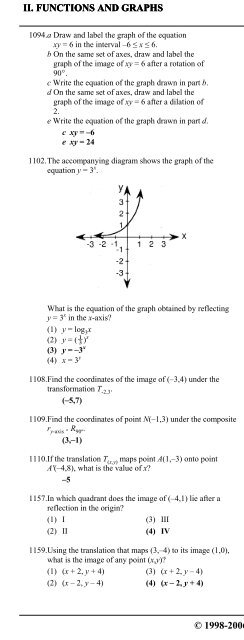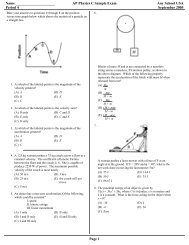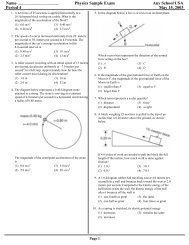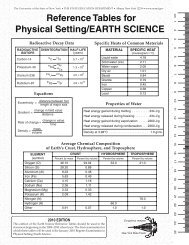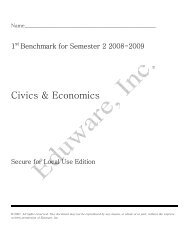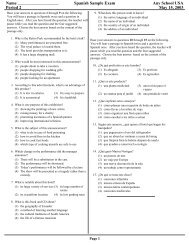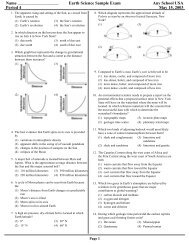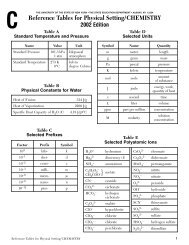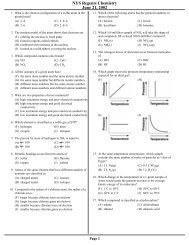Pre-Calculus - Eduware
Pre-Calculus - Eduware
Pre-Calculus - Eduware
Create successful ePaper yourself
Turn your PDF publications into a flip-book with our unique Google optimized e-Paper software.
II. FUNCTIONS AND GRAPHS 4. Transformations Of Graphs<br />
A. Translations, Reflections, And Streches<br />
1094. a Draw and label the graph of the equation<br />
xy = 6 in the interval ‚6 % x % 6.<br />
b On the same set of axes, draw and label the<br />
graph of the image of xy = 6 after a rotation of<br />
90†.<br />
c Write the equation of the graph drawn in part b.<br />
d On the same set of axes, draw and label the<br />
graph of the image of xy = 6 after a dilation of<br />
2.<br />
e Write the equation of the graph drawn in part d.<br />
c xy = ‚6<br />
e xy = 24<br />
1102. The accompanying diagram shows the graph of the<br />
equation y = 3 x .<br />
1165. What is the image of the point (‚3,‚1) under the translation<br />
that shifts (x,y) to (x ‚ 2,y + 4)?<br />
(1) (‚1,3) (3) (‚5,3)<br />
(2) (‚1,‚5) (4) (‚5,‚5)<br />
1170. a On graph paper, draw the graph of the<br />
equation y = x 2 ‚ 4x + 4, including all values<br />
of x from x = ‚1 to x = 5. Label the graph a.<br />
b On the same set of axes, draw the image of the<br />
graph drawn in part a after a translation that<br />
maps (x,y) -(x ‚ 2,y + 3). Label the image b.<br />
c On the same set of axes, draw the image of the<br />
graph drawn in part b after a reflection in the<br />
x-axis. Label the image c.<br />
d Which equation could represent the graph<br />
drawn in part c?<br />
(1) y = ‚x 2 + 4x ‚ 4<br />
(2) y = x ‚ 3<br />
(3) y = ‚x 2 ‚ 3<br />
(4) y = ‚x 2 + 3<br />
d 3<br />
1176. If a translation maps point A(‚3,1) to point A'(5,5), the<br />
translation can be represented by<br />
(1) (x + 8, y + 4) (3) (x + 2, y + 6)<br />
(2) (x + 8, y + 6) (4) (x + 2, y + 4)<br />
What is the equation of the graph obtained by reflecting<br />
y = 3 x in the x-axis?<br />
(1) y = log 3<br />
x<br />
(2) y = (¢) x<br />
(3) y = ‚3 x<br />
(4) x = 3 y<br />
1178. The parabola shown in the diagram is reflected in the x-axis.<br />
1108. Find the coordinates of the image of (‚3,4) under the<br />
transformation T -2,3<br />
.<br />
(‚5,7)<br />
1109. Find the coordinates of point N(‚1,3) under the composite<br />
r y-axis †<br />
R 90º<br />
.<br />
(3,‚1)<br />
1110. If the translation T (x,y)<br />
maps point A(1,‚3) onto point<br />
A'(‚4,8), what is the value of x?<br />
‚5<br />
1157. In which quadrant does the image of (‚4,1) lie after a<br />
reflection in the origin?<br />
(1) I (3) III<br />
(2) II (4) IV<br />
1159. Using the translation that maps (3,‚4) to its image (1,0),<br />
what is the image of any point (x,y)?<br />
(1) (x + 2, y + 4) (3) (x + 2, y ‚ 4)<br />
(2) (x ‚ 2, y ‚ 4) (4) (x ‚ 2, y + 4)<br />
What is the image of the turning point after the reflection?<br />
(1) (2,‚5) (3) (‚2,‚5)<br />
(2) (‚2,5) (4) (5,2)<br />
1180. a On graph paper, draw the graph of the<br />
equation y = x 2 ‚ 6x + 8 for all values of x in<br />
the interval 0 % x % 6.<br />
b On the same set of axes, draw the image of the<br />
graph drawn in part a after a translation of<br />
(x ‚ 3, y + 1) and label it b.<br />
c Write an equation of the graph drawn in part b.<br />
c y = x 2<br />
© 1998-2006 <strong>Eduware</strong>, Inc. 79


